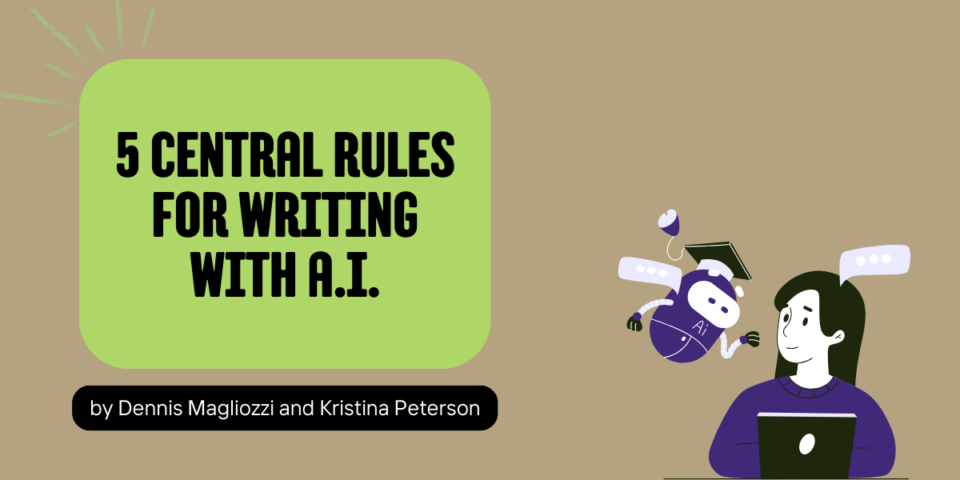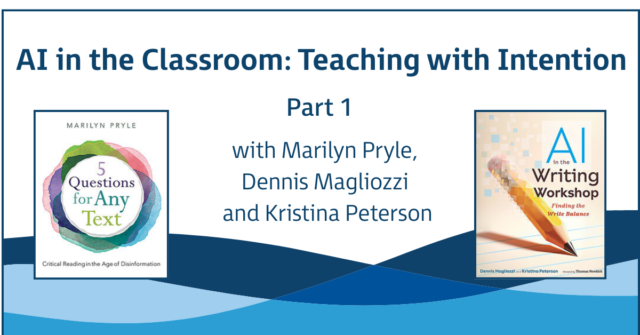
As we navigate the emerging challenges and opportunities presented by generative AI tools, we must practice the core principles that govern effective writing instruction: Focus on the writing process; conference and collaborate with our students; and engage in the writing process as an act of discovery. And we must set some ground rules for our engagement with AI.
Write First
When engaging AI in the writing process, always start your piece independently and allow your ideas to flow naturally before seeking AI assistance. Having something on the table first allows human intelligence (HI) to remain in the driver’s seat, and not the other way around.
Struggle Second
Be willing to try to solve your own challenges and roadblocks before going directly to AI. The potential downfall of working with AI is that we will choose it as a path of least resistance, but the process of writing is one full of starts and stops, a flurry of ideas followed by moments of quiet reflection. This is not just part of the writing process, it is part of the thinking process as well. AI is here to help us in our thinking, not to do all the thinking for us.
Prompt Third
The first step into getting the most from generative AI is to carefully craft what you type into the text box to get the most precise and valuable information. This is known as prompt engineering. The old adage “garbage in, garbage out” is no truer than when seeking support from generative AI. The quality of a prompt directly impacts the quality of its response. Vague or ambiguous prompts will produce vague or ambiguous responses. Users have to think very carefully about what they’re looking for from it. Well-thought-out and specific prompts can unlock the full potential of generative AI, ensuring that users receive the feedback they want. It requires the user to engage in rhetorical and critical thinking skills and strategies to craft an effective prompt from the software.
Keep these in mind:*
1. Provide context: Indicate the perspective you want the chatbot to take/how you want it to respond (as a teacher, as an editor, as a writing coach). This will enhance its responses.
2. Identify what you need: Clearly explain the task you want the bot to complete (design a lesson plan, create a rubric, organize a to-do list).
3. The more specific, the better: If your prompt is incomplete or lacks important context, the chatbot’s response is likely to be just as vague. Detailed and well-defined prompts lead to more precise responses.
* Most generative AI tools are open source, so always avoid giving it sensitive personally identifiable information (PII) like full names, email addresses, or other identifying details.
Question Fourth
Engage in conversation with the feedback you receive. Question, critique, and expand on the feedback. Develop a habit of critically considering AI’s suggestions. Ask yourself, “Does this align with my attempt? How can I make it better?” Don’t copy. Don’t take everything word for word. Consider how you can make this your own. How can you stay true to your authentic voice and intent?
Reflect and Be Transparent
- Reflection encourages growth. It ensures that we keep the focus on the process. It pushes writers to constantly enhance their skills and their creative and critical thinking abilities. We ask our students to consider how AI aided them in the writing process. We want to know what insights they gained from the collaboration. We want them to reflect on how their writing improved or changed. And most importantly, we want them to consider how they can apply what they learned today to tomorrow’s tasks.
- Transparency is an essential part of the writing process, especially in education. We have always taught our students it is crucial to acknowledge the use of outside sources and to cite them, and the use of AI is no different. This means understanding and clearly articulating how AI has contributed to written work. Teachers have to open the channels of communication with students about how they used AI as an aid rather than shut down the discussion. Without an open dialogue, we can always expect to find ourselves suspicious of who used AI in a given essay.
The workshop setting and these rules not only foster ethical and responsible use of AI, but they also encourage students to become more aware and self-reflective throughout the process.



